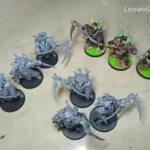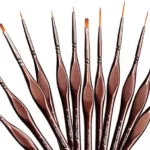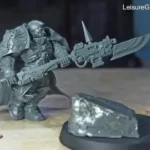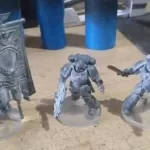Tips for hand brushing miniatures
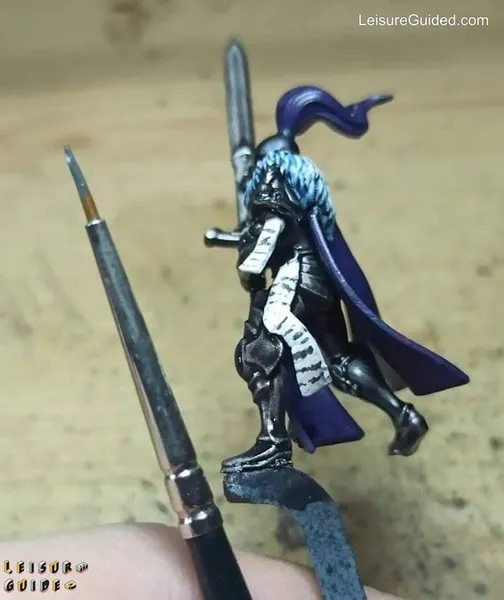
Painting small surfaces is almost often never an issue for many mini painters, but when trying to paint larger areas with solid colors it can start to look bad.
The trick is to know what to do when hand brushing.
- Apply primer
- most mini painters don’t prime their miniatures, but you should start with a primer to provide a uniform base for the paint.
- Be sure to clean your kit surface before applying primer. Use a damp cloth and avoid paper towels because they leave fibers on the painting surface.
- Thinning
- Thin the paint substantially so it runs easily off the brush. I find around 60/40 works in favor of many acrylic and enamel paints. A lot of painters may think this thinning ratio is a lot, but it is key to getting a smooth finish. If the paint is too thick, you will end up overworking it and creating more brush marks.
- Never thin the paint directly in the pot. Always thin using a new container, just what you think you’ll need. The thinner will break down the pigments, and the paint won’t last very long.
- Be sure the paint is thin enough so it self-levels before it dries.
- Drying tips
- As you layer paints, allow it to fully dry before applying another coat.
- Layers
- Don’t overload the brush. If you take too much off the brush, you can always go back for more. If you lay down too much, you end up overworking it.
- Avoid going over the same area as you layer paints
- Do 3 or 4 thin coats, and you should get a smooth finish.
- Cleaning the brushes
Brush maintenance is one of the biggest parts of hand brushing since the outcome of the technique also depends on how good the brush is. So, after using the brush you should keep it clean before stowing it.
When I paint with enamels, I use my enamel paint thinner or turpentine as a cleaning solution to rid the paints off the brush.
For acrylics, I use White Spirit to clean my brush immediately after use and rinse it off with warm soapy water. Then, I shape the bristles to form a sharp pointed end.
After this, I air dry them because I see no need to wipe them with a cloth. It increases the risk of getting tissue or cloth fibers on the bristles.
I also use a hair conditioner every few months to keep it supple. Well, this is a technique that works for me but might not sit well for many builders.
Most builders recommend touching the bristled ends to a folded tissue or paper towel with caution not to swirl it around on the tissue or towel before airdrying.
Tips For Choosing Paint – Enamel or acrylic
| Enamel | Acrylic |
| Oil-based | Water-based |
| Slow dry time | Dries quickly |
| Bonds easily on a surface without a primer | Requires a primer to bind to the surface |
| Toxic | Non-toxic |
| Needs turpentine to clean | Water is enough to clean the paint |
These two paints are best suited for hand brushing your miniatures, but they differ in their usage, drying properties, and (at times) even their finish.
Acrylic
Of the two, acrylic paints are the most popular choice among builders (even me) because they are easy to thin with water and dry easily. Plus, they don’t have a foul smell making it easy to paint in an enclosed space.
But there’s a catch; they aren’t as durable as enamel paints.
Regardless, their water-based thinning solution means you can easily touch up acrylic paints if it ever fades or smears. And a bonus, clean-up is a breeze if they ever spill. Just get water and dish soap to wipe it off.


Enamel
Enamel paints are the opposite of acrylics since they are oil-based.
Enamels offer a durable and permanent finish, whereas acrylics don’t due to their water-based characteristics. But, no matter how thick and a stronger option they are, they are not as popular as their acrylic counterparts.
Regardless, I really think they are a great hand brush paint because they provide better color coverage along with a smoother finish and leave a stronger coat on your mini when applied.
You can also manipulate them after they’ve dried, making them a good choice for hand brushing.
Plus, they work well with specialty enamel thinners. But, unlike acrylics, where you use 60/40 thinners, the amount of thinner you use to soften the texture of your paint depends on the finish you intend to achieve.
Just make sure you don’t use too small an amount of thinners as the results in a thicker coat, or 50/50 thinner with paint as it creates a nearly translucent color (except this is your aim). Nonetheless, enamel paints only require a few drops of thinner to soften the paint.
The downside of using enamel paints is that take a longer time to dry and are noxious, thanks to their turpentine base.
So, you need to wear protective gear like a rubber glove and respirator to keep it off your hands and avoid inhaling it. And unlike acrylics that allow clean-ups with water and dish soap, you can’t clean an enamel paint without using an acidic solvent.


What kind of paint is best for painting miniatures?
Not all paints behave the same way. Some painters love enamels because of the durability and glossy sheen it offers.
However, the slow dry time, foul smell, and almost challenging cleaning chore make using them on miniatures a tasking.
Many miniature painters prefer acrylics because it has a short drying time, are easy to clean, and allow you to change the flow and viscosity of the paint without changing the color saturation.
So, between acrylic and enamel paints, acrylics work best for painting minis.

